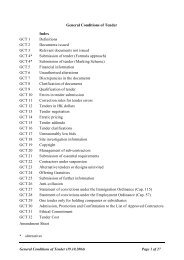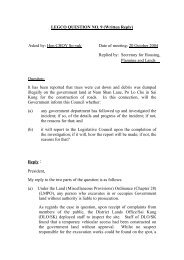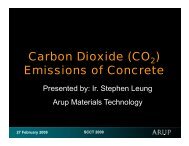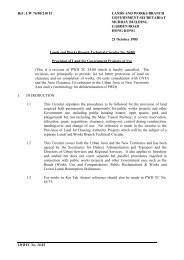Replies to Questions from Finance Committee Members
Replies to Questions from Finance Committee Members
Replies to Questions from Finance Committee Members
Create successful ePaper yourself
Turn your PDF publications into a flip-book with our unique Google optimized e-Paper software.
Examination of Estimates of Expenditure 2003-04<br />
CONTROLLING OFFICER'S REPLY TO<br />
INITIAL WRITTEN QUESTION<br />
Head: 43 - Civil Engineering Department Subhead (No. & title):<br />
Programme: (7) Management of Construction and Demolition Materials<br />
Controlling Officer: Direc<strong>to</strong>r of Civil Engineering<br />
Direc<strong>to</strong>r of Bureau: Secretary for the Environment, Transport and Works<br />
Question: Please reply <strong>to</strong> the following questions related <strong>to</strong> Programme (7)<br />
“Management of Construction and Demolition Materials”:<br />
(a) What is the unit cost of handling public fill by the Administration?<br />
In the coming 3 years, does the Administration have any plan and<br />
measure <strong>to</strong> handle and reduce the ever increasing amount of public fill?<br />
If affirmative, what are the details of the plan and the estimated<br />
expenditure?<br />
(b) What is the expenditure in the recycling of inert construction and<br />
demolition materials by the government? Why is the actual quantity<br />
of recycled construction and demolition materials produced less than<br />
that of the original forecast (0.15 m <strong>to</strong>nnes)? In 2003-04, why does<br />
the forecast production increase?<br />
(c) Please give an account of the long-term strategy being formulated by the<br />
Administration for handling inert construction and demolition<br />
materials and when will it be completed?<br />
Asked by : Hon. LEE Chu-ming, Martin<br />
Reply: (a) The unit cost of handling public fill is about $26 per <strong>to</strong>nne. In<br />
2003-04, the Administration will mainly rely on reclamation projects<br />
and temporary fill banks <strong>to</strong> handle public fill. We will continue our<br />
best efforts <strong>to</strong> reduce the amount of public fill and <strong>to</strong> recycle hard inert<br />
materials generated. The Public Fill <strong>Committee</strong> and Works<br />
Departments’ Vetting <strong>Committee</strong> will scrutinize Construction and<br />
Demolition Materials Management Plan of public works projects. In<br />
2003-04, the Administration has reserved $123.9 m for the<br />
management of construction and demolition materials. We are still<br />
exploring possible measures <strong>to</strong> tackle the public fill problem after<br />
2003-04, including the possibility for exporting public fill for reuse in<br />
projects outside Hong Kong.<br />
(b) In 2002, the government has spent $26 m for the setting up and $6 m<br />
for the operation of the inert construction and demolition material<br />
recycling facility in Tuen Mun. The 2002 actual production of<br />
50,000 <strong>to</strong>nnes of recycled aggregates was less than the original<br />
forecast of 150,000 <strong>to</strong>nnes because most of the projects that generated<br />
inert material during the year produced soft material that is not<br />
suitable for recycling.<br />
In 2003-04, the production of recycled aggregates is forecasted <strong>to</strong><br />
increase as several demolition projects (eg. Yuen Long Estate and<br />
North Point Estate) would generate more hard inert materials suitable<br />
Reply Serial No.<br />
ETWB(E)029<br />
Question Serial No.<br />
0534







